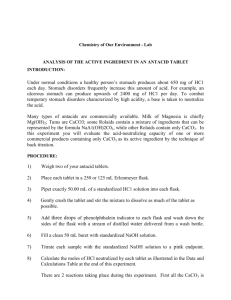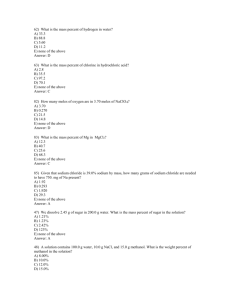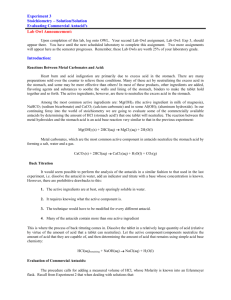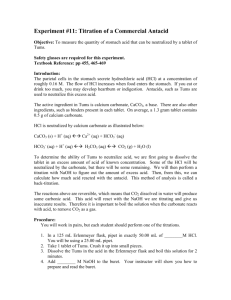Chem 111, Exp 3, Fall 2000
advertisement
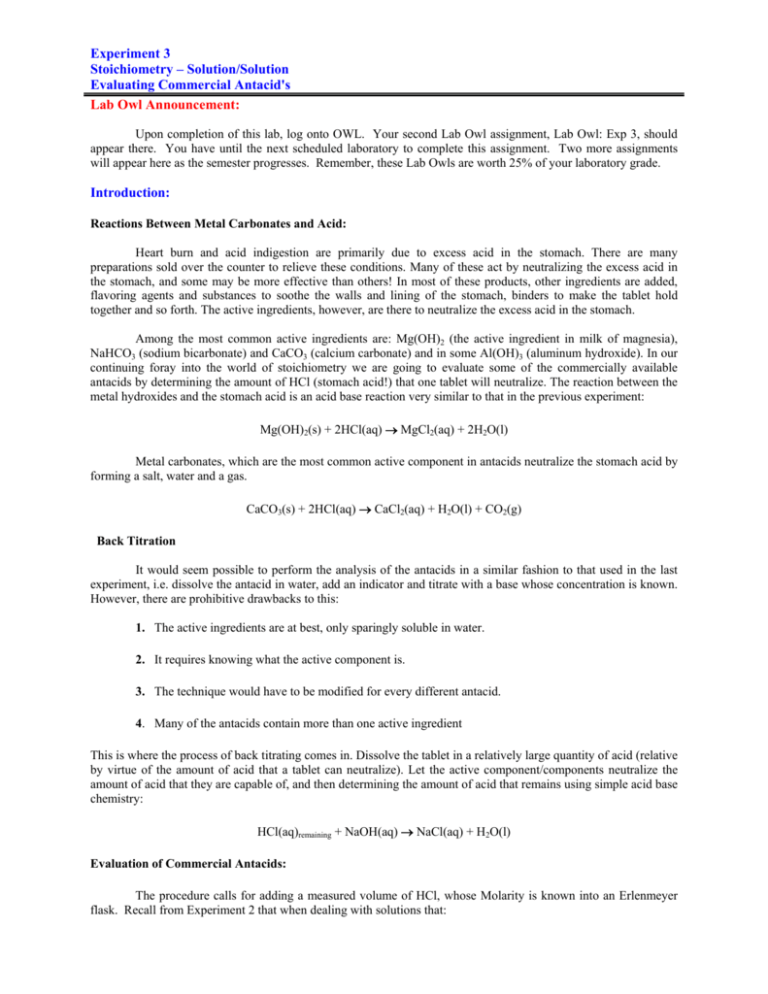
Experiment 3 Stoichiometry – Solution/Solution Evaluating Commercial Antacid's Lab Owl Announcement: Upon completion of this lab, log onto OWL. Your second Lab Owl assignment, Lab Owl: Exp 3, should appear there. You have until the next scheduled laboratory to complete this assignment. Two more assignments will appear here as the semester progresses. Remember, these Lab Owls are worth 25% of your laboratory grade. Introduction: Reactions Between Metal Carbonates and Acid: Heart burn and acid indigestion are primarily due to excess acid in the stomach. There are many preparations sold over the counter to relieve these conditions. Many of these act by neutralizing the excess acid in the stomach, and some may be more effective than others! In most of these products, other ingredients are added, flavoring agents and substances to soothe the walls and lining of the stomach, binders to make the tablet hold together and so forth. The active ingredients, however, are there to neutralize the excess acid in the stomach. Among the most common active ingredients are: Mg(OH)2 (the active ingredient in milk of magnesia), NaHCO3 (sodium bicarbonate) and CaCO3 (calcium carbonate) and in some Al(OH)3 (aluminum hydroxide). In our continuing foray into the world of stoichiometry we are going to evaluate some of the commercially available antacids by determining the amount of HCl (stomach acid!) that one tablet will neutralize. The reaction between the metal hydroxides and the stomach acid is an acid base reaction very similar to that in the previous experiment: Mg(OH)2(s) + 2HCl(aq) MgCl2(aq) + 2H2O(l) Metal carbonates, which are the most common active component in antacids neutralize the stomach acid by forming a salt, water and a gas. CaCO3(s) + 2HCl(aq) CaCl2(aq) + H2O(l) + CO2(g) Back Titration It would seem possible to perform the analysis of the antacids in a similar fashion to that used in the last experiment, i.e. dissolve the antacid in water, add an indicator and titrate with a base whose concentration is known. However, there are prohibitive drawbacks to this: 1. The active ingredients are at best, only sparingly soluble in water. 2. It requires knowing what the active component is. 3. The technique would have to be modified for every different antacid. 4. Many of the antacids contain more than one active ingredient This is where the process of back titrating comes in. Dissolve the tablet in a relatively large quantity of acid (relative by virtue of the amount of acid that a tablet can neutralize). Let the active component/components neutralize the amount of acid that they are capable of, and then determining the amount of acid that remains using simple acid base chemistry: HCl(aq)remaining + NaOH(aq) NaCl(aq) + H2O(l) Evaluation of Commercial Antacids: The procedure calls for adding a measured volume of HCl, whose Molarity is known into an Erlenmeyer flask. Recall from Experiment 2 that when dealing with solutions that: M= mol V(L) Lets rearrange this to a more useful format, since what we want to know is the number of moles of HCl that is in the Erlenmeyer flask: mol = M x V(L) Thus the number of moles of HCl initially present is simply the Molarity of the HCl times the Volume (converted to liters). Now we add the antacid and it reacts with some of the HCl but not all of it. How do we determine what remains? We titrate it with sodium hydroxide solution whose concentration we know – recall experiment two. HCl(aq) + NaOH(aq) NaCl(aq) + H2O(l) At the end point of the titration we know the volume of NaOH needed to neutralize the remaining HCl, and we also know the Molarity of the NaOH, thus mol NaOH = M x V(L) Again just as in experiment 2, we use the balanced chemical equation to convert our moles of NaOH added to moles of HCl that remained # mol NaOH x HCl x NaOH = # mol HCl Where x is to coefficient in front of the NaOH and the HCl respectively in the balanced chemical equation. This gives us moles of HCl remaining after the antacid has reacted. Simple subtraction reveals the number of moles of HCl that reacted with the antacid. In order to do a comparison between the antacids you will need to calculate: 1. The number of moles of acid neutralized per gram of tablet. (The amount of acid neutralized divided by the mass of the tablet) 2. The number of moles of acid neutralized per $1 cost of the tablet. (The amount of acid neutralized divided by the cost of the tablet in $) Experimental Procedure Evaluation of Commercial Antacids. 1. Obtain three antacid tablets. Record the brand name, the number of tablets in the container and the cost of the tablets. Trial T Trial T is critical in this determination. It is used not only to get an estimate of the approximate end-point but it is also used to determine the appropriate amount of HCl required for the particular brand of antacid that you are analyzing. 1. Record the weight of one of the antacid tablets to the nearest milligram and place it in a clean 125-mL Erlenmeyer flask. 2. Add 15mL of ~1M HCl and 10mL of water. Use the designated 'Repipet' to dispense the HCl. Make sure you record the exact Molarity of the HCl. 3. Add three to four drops of phenolphthalein and titrate until you see a permanent slight pink color. 4. Before progressing to Trials 1&2, do all the calculations for this trial and have your TA check your method of calculation. Note: For best results you are looking for an endpoint upon the addition of 20-30mL of NaOH. If this was not the case then you will have to adjust the amount of HCl to initially add so that this is the case for Trials 1 and 2. Check with your TA if you need to do this. Trial 1 and 2: 1. Repeat the above procedure with the two remaining antacids and when you have done so determine: a. The average moles of acid neutralized per gram of tablet. b. The average moles of acid neutralized per $1 cost of the tablet. Chem 111 Experiment 3 Spring 2016 Stoichiometry: Solution:Solution….Evaluation of Commercial Antacids Name: Lab TA: Mon Tue(am) Tue(pm) Wed Thu(am) Thur(pm) Fri Lab Day Grade >95 >90 >85 >80 >70 <70 Report: Prelaboratory Quiz Score: Data Collection and Calculations: Trial P 1. Molarity of the NaOH solution (From Exp. 2). 2. Tablet brand name. Cost per tablet.. Mass of the Tablet. 3. Molarity of the HCl solution (given on bottle). Volume of HCl added. Moles of HCl added. 4. Initial buret reading. Final buret reading. Volume of NaOH added. Moles of NaOH added. 5. Moles of HCl neutralized by the NaOH. Moles of HCl neutralized by the Tablet. Average moles of HCl neutralized by the Tablet. Average moles of HCl neutralized per gram of tablet. Average moles of HCl neutralized per $1 of tablet. Trial 1 Trial 2 Trial 3 (if required) (Use Trial T for 3 &5) Show detailed calculational method for: 3. Moles of HCl added. 5. Moles of HCl neutralized by the Tablet. Collect the following data from another student using different brand antacid: Your Antacid Colleague's Antacid Brand Name: Moles of Acid neutralized per gram of tablet Post Laboratory Question: Your TA will not help you with this final question. A new 'Super-Antacid' (or so the commersial claims) just released onto the market was analyzed in a manner similar to the experiment that you just did. A single tablet weighing 0.3541g was added to 25mL of 0.981M HCl. The acid remained after the tablet had reacted required 10.31mL of 0.182M Ca(OH)2 to neutralize it. How many moles of acid were neutralized by the tablet. How does this new 'Super Antacid' compare to the one that you analyzed?
